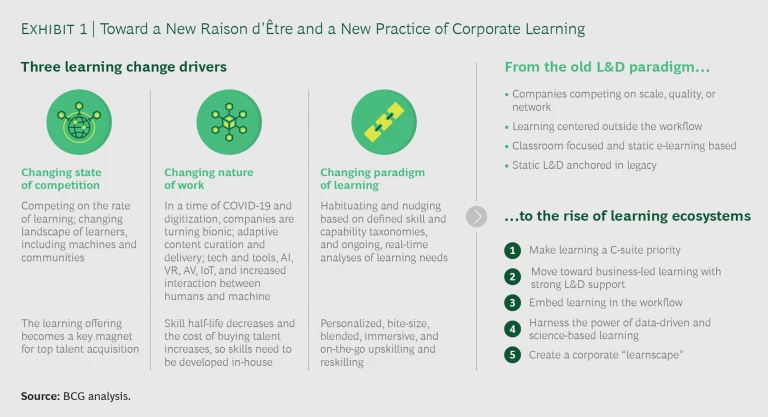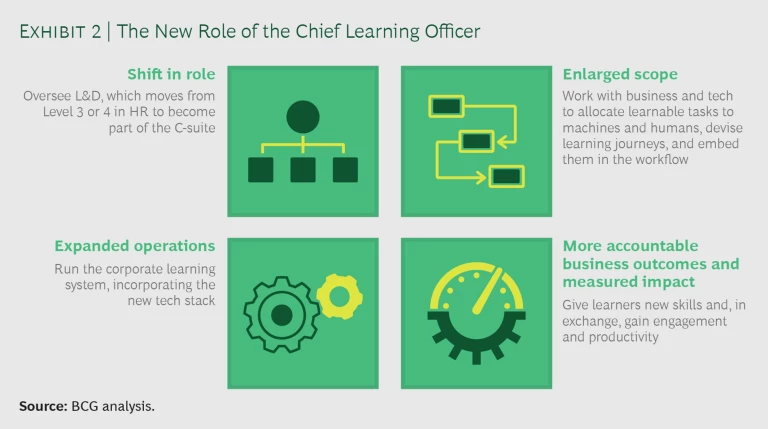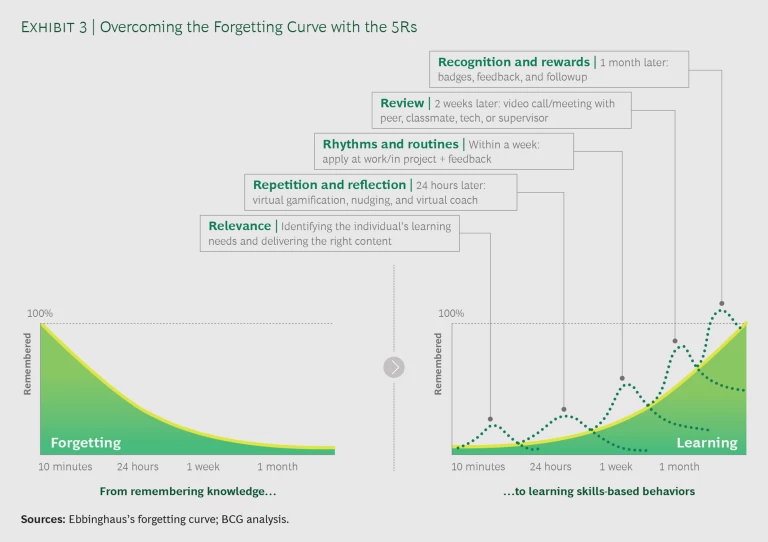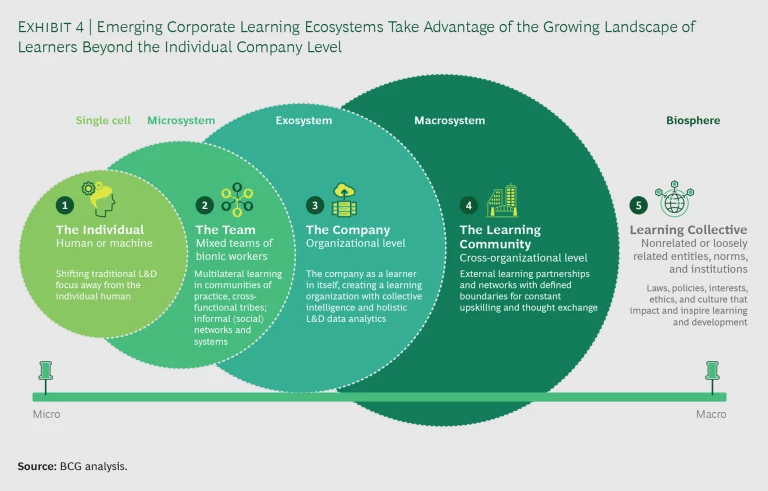Companies face a Herculean challenge in today’s fast-evolving work environment. Such is the pace of change that businesses are disappearing more quickly than ever before. If they are to survive, never mind thrive, company leaders must learn to adapt. And here, the operative word is learn.
Much has been said about companies’ capacity to adapt. Much less has been said about companies’ capacity to learn. And yet, in our estimation, a company’s capacity to learn determines its capacity to adapt and, ultimately, its chances of surviving far into the future. If your company isn’t learning, it isn’t growing—and it’s probably on a losing path.
Of course, most companies have a learning and development function within their Human Resources department. Corporate learning has a long, albeit checkered, history. But, as we show in this report, some new forces require company leaders to take two urgent actions: first, rethink the purpose of learning within their business; and second, reinvent the organization of learning within their business.
Three Forces Changing Corporate Learning
Every CEO is now focused on responding to the enormous challenges posed by the global pandemic caused by COVID-19. But the companies that have the most forward-thinking approach to learning appear to be more resilient in the face of this greatest of unforeseen events. Clearly they have understood the three forces that are shaking the foundations of the corporate learning environment. As soon as the worst of the crisis is over, every CEO must do the same.
Let’s look at each of these forces in turn. (See Exhibit 1.)

The Changing Basis of Competition—The Rate of Learning
Companies used to compete on the basis of their positional advantage—the price and quality of their goods and services; their ability to influence suppliers, consumers, and others in their network; and their ability to recruit and retain the most talented people. At the turn of the century, however, the world became more dynamic, and companies started to compete on the basis of their adaptive advantage—their ability to work in agile ways, innovate quickly, and adopt new approaches in response to changing marketing conditions. Now, although these remain important, another basis of competition has risen above them all in the digital age: learning advantage. The winners of tomorrow will be those that can accelerate their rate of learning.
The winners of tomorrow will be those that can accelerate their rate of learning.
Modern technologies such as IoT sensors, digital platforms, and AI are quickening the rate at which companies generate, gather, and process information. In effect, these technologies bypass the slow, unwieldy managerial hierarchies that have traditionally dominated corporate decision making. As a result, companies are starting to operate at superhuman speed, learning about the market and reacting to it in seconds.
But there has to be a human corollary to this digital transformation. If a company is going to use advanced technology to accelerate the rate of learning, the individuals and teams that make up the company must accelerate their rate of learning, too.
The Changing Nature of Work—The Rise of the Bionic Company
Even before the onset of the global pandemic, the world of work was rapidly changing, as companies adapted to the growing prevalence of digital technology in daily life. At BCG, we have been talking for some time about what we call the rise of the bionic company : the innovative fusion of human and machine in the workplace.
But since the emergence of COVID-19, which forced governments around the world to impose stringent lockdown measures, more than 300 million employees have been obliged to work remotely, away from their offices. This, we believe, has catapulted companies three to five years into the digital future.
Companies will need to upskill or reskill approximately 60% of their workforce over the next two to five years.
It is a future that won’t stand still. Our research suggests that companies will need to upskill or reskill approximately 60% of their workforce over the next two to five years. But given the pace of change, they will need to go further in order to ensure a continuous flow of innovation, creativity, and skills from their employees. The average half-life of a skill is now just five years. Consequently, we calculate that 1 billion jobs will need to be reconfigured over the next ten years. It’s a daunting task.
The Changing Paradigm of Training—The New Science of Learning
Over the past few years, behavioral economists, neuroscientists, and cognitive psychologists have achieved major breakthroughs in their understanding of how people learn . They have found that people learn best when the training is personalized, packaged in bite-size formats, incorporated into the daily work routine, and supported with timely nudges and reminders. This new science of learning has not yet fully entered the workplace—but when it does so, it promises to revolutionize the way companies perform.
Companies must change not only how they deliver learning within the workplace, but also what they deliver. Traditionally, corporate learning has been the Cinderella of the broader education system—unglamorous, underappreciated, and tasked with topping up the know-how and other skills acquired in school and university. How many people would willingly single out a corporate learning course as the educational experience that made the greatest difference to their career—rather than the class of an inspirational professor or the sage advice of a mentor or the startling revelations of a game-changing book? Not many.
But the ambition of corporate learning in the future must be to provide that critical, career-defining learning experience.
The New Raison d’Être and Practice of Corporate Learning
Given the new competitive environment, the rise of the bionic company, and the emergence of a transformative science of learning, company leaders must rethink the purpose and reinvent the practice of learning within their business.
In most companies, the purpose of learning is simply to upskill employees. As a result, CEOs have mistakenly delegated the company’s vital learning agenda to their L&D function—which all too often focuses narrowly on creating and delivering content through in-person or online courses that are organized outside the day-to-day flow of work and lack any analytical backbone for assessing who is learning what and for which strategic reason. If this was ever the right way to conduct corporate learning, it is certainly wrong now.
Going forward, CEOs should take back overall responsibility for corporate learning and give it a new raison d’être—namely, to improve the business’s performance in a way that enlarges its overall contribution to society. There can be no other rationale. Upskilling and reskilling employees are parts of the task of improving a company’s performance, of course. But the task is much greater than that—and it has significant implications for the organization of learning within a business.
CEOs should give corporate learning a new raison d’être: to improve the business’s performance in a way that enlarges its overall contribution to society.
When company leaders reconsider the rationale for corporate learning, they will reach an inescapable conclusion: the practical organization of corporate learning must be completely reinvented. This is a major task. It cannot be undertaken lightly. But some companies have already begun to reinvent their corporate learning organization, and they have done so by taking five crucial steps.
Step 1: Develop a New Strategy and Make Learning a C-Suite Priority
The first step for CEOs to take is to develop a new company-wide strategy that recognizes learning as the internal engine of organizational change and optimal performance. In this sense, learning is about improving not only the skills of individuals and teams but also the modus operandi of the company. It is fundamental to the success of the entire business.
To reflect the new significance of learning within the company, CEOs should make learning a C-suite priority. One way to do this would be to switch responsibility for this critical activity from the HR function to a dedicated L&D function headed by a chief learning officer who sits on the executive board. (See Exhibit 2.) Giving the CLO a seat at the table would send a clear message that the company regards learning as a strategically important function. Much the same was done three decades ago, when forward-thinking CEOs switched responsibility for their company’s data from the IT department to a dedicated chief data officer with a seat on the board. This was a smart response to the fact that the vast wealth of data being created by the new information technologies was fast becoming critical to business success.

But this is not just about moving chairs around in the boardroom. The new CLO—or whoever takes on this role in the boardroom—should receive an expanded mandate, with responsibility for building a new learning and development function, embedding relevant learning in the workflow, harnessing the power of data-driven and science-based learning, and creating what we call a corporate learnscape.
The new CLO should be responsible for creating what we call a corporate “learnscape.”
It is an enormous challenge. This is why we believe that the ideal candidate to oversee a company’s L&D activities is someone with the vision, energy, creativity, and determination to be able to ascend to the top of the company—a potential CEO.
In 1990, Jack Welch created the world’s first CLO position, appointing Steve Kerr to the role at General Electric. Kerr later moved to Goldman Sachs, where he fulfilled the same role. But since then, surprisingly few companies have accorded the CLO role the status it needs to make a difference. Other Fortune 500 companies that take the role seriously include Citi, Merck, Facebook, and Google—although Facebook uses the title global head of L&D, and Google has a vice president of people development.
Step 2: Build a New Learning and Development Function
The CEO and the whole executive team must take overall responsibility for making learning a strategic imperative for the company. The task is simply too important to be delegated to one or two executives, no matter how senior. For practical reasons, they will need to partner with the company’s centers of excellence for people and organizational management—namely, the HR function and, above all, the L&D function—if they are to deliver the necessary change. Unfortunately, most L&D functions are not fit for this purpose.
Our research suggests that four out of five CEOs are asking the following questions:
- Why are we not capable of systematically upskilling and reskilling our employees?
- Why can’t we learn and adapt to the changing business environment as fast as our competitors?
- How can we future-proof our talent?
Part of the answer lies in the current state of the L&D function. In many companies, L&D is alarmingly outdated, held back by a legacy mindset that impedes progress and puts the future of the whole business at risk. Company leaders must undertake a radical overhaul of their L&D function, introducing new, more flexible organizational models and roles that reflect the new skills required by the function and allocating an expanded budget for its use.
We see five main types of roles in the future L&D organization:
- Learning architects will translate business needs into end-to-end learning solutions that mix immersive classroom, online, and on-the-job approaches.
- Content curators will source a wide variety of new skills-based material from all kinds of providers in the learning ecosystem.
- Learning technologists will design and implement the right technology stack with the right mix of tools—from traditional learning management systems (LMSs) to modern learning experience platforms (LXPs)—and fit-for-purpose learning apps.
- Digital designers will apply their expertise in user experience (UX) and user interface (UI) design as well as in digital product development.
- Data scientists will help the company unleash the power of the data collected through online learning platforms by marrying them with performance management data and then measuring the true effectiveness of learning programs.
With these new people—from diverse walks of life—on board, the L&D function will start to look very different. And like the rest of the company, it will have to act differently, too, abandoning old ways of working and embracing more agile, iterative, customer-centric, and cross-functional approaches. Inevitably, this change will come with a new price tag: corporate learning will likely require a higher budget. In our experience, companies underinvest in L&D. So how much should CEOs set aside for learning? The answer will vary from company to company and from sector to sector—but as a rule of thumb, CEOs who want to prioritize learning should aim to double the amount they currently spend on L&D activities. The CEO’s task is not simply to increase the size of the budget, however; it is also to increase the efficiency of budgeted spending. Right now, too much gets wasted on activities that fail to achieve positive learning outcomes and boost overall company performance. Indeed, in our estimation, efficiency can—and must—be tripled.
Companies that have created a strong learning and development capability include Audi, Lendlease, and Salesforce. Salesforce, a cloud-based software company, has developed a learning platform called Trailhead that provides ways to learn in-demand skills, earn résumé-worthy credentials, and connect to the company’s ecosystem of learners. The “trails” are, as the company explains, “guided learning paths through modules and projects.” Put another way, they are an individual’s “personal game plan for exploring new skills.” Salesforce also has a Trailhead Academy, which offers in-person and virtual learning experiences. Some companies, such as Autodesk, use the Trailhead platform to drive learning across their own organization.
Step 3: Embed Relevant Learning in the Everyday Workflow
The new science of learning calls for a new way of delivering corporate skills-based learning. For the past century, much pedagogic thinking has been based on the work of Hermann Ebbinghaus, a brilliant nineteenth-century German psychologist who pioneered the experimental study of memory and developed the forgettingcurve, which revealed how rapidly people forget what they learn for the first time. The forgetting curve was useful to companies in an era when learning and development chiefly involved imparting knowledge—and knowing what. Now, however, companies need to focus not just on knowing what but on knowing how because in today’s fast-paced world—where the what changes all the time—the application of knowledge has become especially critical. This is why we recommend that companies forget the forgetting curve and focus instead on the learning curve, which demonstrates how a series of timely interventions can dramatically improve the way employees remember essential business skills.
Only about 10% of corporate learning happens in formal in-person or online courses. Why? Because most people fail to recall more than 75% of the information they learned the week before unless they have reason to use it in the workplace. For this reason, companies must find a way to embed relevant learning in their employees’ everyday workflow.
Only about 10% of corporate learning happens in formal in-person or online courses.
We recommend the “5Rs” approach. (See Exhibit 3.) Although these five timely interventions underpin the learning curve, they do not yet constitute scientifically proven fact. Nevertheless, we now routinely recommend them to our clients, and the results are encouraging. This is because they provide an answer to the question of how companies can use new skills and new knowledge to develop new behaviors.

Relevance is the starting point. If the new skills and know-how are to stick, they must be relevant to the individual or team as well as to the whole company. Given appropriate autonomy, individuals and teams are in the best position to determine what is relevant to them. Of course, companies will want to match personal learning preferences with the company’s analyzed skills gaps. But if companies can trust employees to choose what they want to learn (by identifying what is relevant to them), rather than telling them what to do, this is the first step toward success. It satisfies what behavioral economists call intrinsic motivation.
Content is not the sole determinant of relevance, however. In addition, relevant job-related must be delivered to the learner at the right time, in the right format, and precisely when and where the learner needs it. As a result, besides being personalized, it must also be bite-size, blended, immersive, and on the go.
So, beyond satisfying the criteria for relevance, companies’ learning programs must incorporate what behavioral economists call extrinsic motivation. This is where the other four Rs come in:
- Repetition and reflection involve nudging and encouraging employees—via a company learning app, a gamification tool, or a virtual coach, for example—as a way to reinforce their learning within 24 hours of their previous learning experience. Repetition via reminders is an important aspect of such reinforcement, but so is reflection on the learning that each individual has already achieved.
- Rhythm and routines of the business offer opportunities not only to incorporate the new learning into everyday patterns at work but also to deliver feedback and further embed learning in the course of the workflow within a week of initial learning.
- Review entails assessment of the individual’s learning progress with peers, classmates, colleagues, or a supervisor within two weeks of the learning experience, in order to help identify potential gaps, necessary additional learning cycles (termed micro-learning cycles), and other learning needs.
- Recognition and rewards for achieving long-term learning involve having company leaders publicly acknowledge successes, including awarding badges and certificates to individuals for their learning achievements after a month of new learning.
Relevant, personalized, easily digestible content linked to current work and reinforced by virtual coaching, nudges, and gamification will drive employees’ engagement. One way to help amplify the success of this process is to develop what we call learning journeys. Most companies deliver corporate learning as a curriculum for a particular group (for example, shop floor workers or factory managers) or for a particular task (for example, onboarding). But organizing corporate learning as a series of learning journeys allows companies to provide personalized learning that, at the same time, boosts the business’s performance. These learning journeys are typically expressed as questions. One classic learning journey for an employee involves asking, “How can I increase my value?” For CEOs, that same journey can be framed in a different way: “How can I maximize the potential of my employees?” One early adopter of this approach was BHP, the Anglo-Australian mining and metals company, which has designed and implemented individual learning journeys for more than 6,000 managers, integrating learning into the workflow with on-the-job nudging and virtual coaching.
Step 4: Harness the Power of Data-Driven and Science-Based Learning
The new model of corporate learning that we advocate will depend on highly digitized AI- and machine-learning-based technology platforms. They will make possible the new, relevant, personalized approaches to corporate learning. They will ensure that companies can readily incorporate individual and team learning experiences into the rhythms and routines of the everyday workflow. They will permit the curation of content that is aligned with corporate skills assessments and personal learning preferences.
The new model of corporate learning will depend on highly digitized AI- and machine-learning-based technology platforms.
Already, companies are spoiled for choices when it comes to these new learning platforms. Knowledge engines such as Valley autonomously synthesize micro-courses by tracking knowledge inside and outside the enterprise as it changes, helping to predict learners’ behavior in order to keep training relevant, interesting, and fresh. Digital coaching companies such as Humu nudge employees to make their new skills habitual. AI-powered e-learning and gamification providers such as Cognii and Coursera offer a broad range of personalized content with real-time feedback and analytics about learning success. Machine-learning-based knowledge cloud providers such as Edcast aggregate and personalize internal and external learning content. Virtual reality workplace training specialists such as Mursion and VR Training design and orchestrate interactions between learners and avatar-based characters.
Besides changing the way companies deliver corporate learning, these digital technologies help companies determine the mix of hard and soft skills—such as negotiating, problem solving, and critical thinking—that employees need to succeed and to support the business. Although giving employees greater autonomy over their learning (and their choices) reflects, in part, the belief that this will help companies become agile, self-tuning learning organizations, company leaders will not want to leave everything to individual choice. And this is where the new technology comes in. It allows companies to conduct individual employee diagnostics and granular skill assessments to determine when individual employees or teams are ready for the next career step or assignment, what kind of content they like, and what impact their learning journeys will have on their job performance. It also enables companies to determine the impact of individual or team learning on overall business outcomes, thereby closing the loop between the investment needed and the impact achieved.
Kroger, an American retail corporation, is using digital technology to create a smart learning organization. It is partnering with Catalyte, a data science specialist that provides AI-powered solutions to assess and identify candidates for upskilling programs. In this way, it maximizes the return on investment and, at the same time, develops a database of information on high performers (who merit certifications, rewards, and promotions) and low performers (who require customized development programs).
Another company experimenting with new approaches to corporate learning is Sky, a British telecommunications company. It began these efforts after senior executives received feedback from employees that the company was failing to deliver timely learning solutions: by the time it developed, polished, and perfected new training programs for delivery, the learning needs in the business had changed. To tackle the problem, Sky decided to produce learning solutions in real time, reducing their delivery time from 12 months to two weeks and increasing fivefold the number of managers who received learning support. These efforts fundamentally changed not only the delivery process change but also the process for tracking and measuring the learning solutions, which is now connected to individual employee outcomes and overall business outcomes rather than solely to self-reported perceptions of effectiveness.
Step 5: Create a Corporate Learnscape
In a world where companies compete on their rate of learning and where their capacity to learn collectively is a driving force of innovation and growth, it is necessary to create what we call an integrated corporate learnscape. Such a learnscape puts learning at the heart of the company’s mission, with individual learning for employees, collaborative learning for teams and business units, collective learning for the organization as a whole, and community learning for the company and its wider network of stakeholders—including alumni, suppliers, customers, universities, and other content and learning platform providers. (See Exhibit 4.)

A mature corporate learnscape can be a magnet for talented individuals, who are always looking for opportunities to grow. At the same time, it can help companies build a competitive workforce without having to go out and hire ready-made but expensive talent. Properly managed, a corporate learnscape allows individual employees, teams, and business units to take responsibility for their own learning. By giving them autonomy, companies offer employees the opportunity to access the full benefits of a wide range of learning options inside and outside the organization.
Handing so much control over to individual employees, teams, and business units may seem like a bold step, and it may be anathema to executives schooled in hierarchical, top-down management. But evidence from the digital world indicates that companies built on autonomous learning principles learn faster and perform better. Even as they empower the individual, they encourage the exchange of ideas, insights, and know-how across the organization. In short, an integrated learnscape is a powerful force for corporate success.
Several companies have already begun to see the value of creating a corporate learnscape. Google has encouraged an employee-to-employee network called g2g (Googler-to-Googler) that fosters a corporate-wide autonomous learning culture. Vostalpine, one of Europe’s largest steel companies, places employees in innovation hubs to learn, exchange ideas with experts from outside the company, and bring inspiration and innovation back to the business. Other companies developing similar integrated learnscapes include Audi, Microsoft, Uber, and BBVA, the oldest private bank in Argentina.
Foster a Corporate Learning Ecosystem
There is no question that CEOs are facing the toughest of times. For some, the very survival of their company is in doubt. But, however hard it may seem, leaders must focus on plotting their path to a profitable and purposeful future—and in our view that means putting learning at the heart of their enterprise.
They can do this by adopting a two-pronged approach. First, they need to recognize the fundamental goal of learning in the company—which is to gain competitive advantage and improve the performance of the business. Second, they need to reinvent the practical organization of learning within the company, in five ways:
- Develop a business strategy that aligns with the real purpose of learning.
- Build a radically reshaped L&D function.
- Embed relevant skills-based training in the workflow.
- Harness the power of tech-enabled learning platforms.
- Create an integrated learnscape.
By reinventing the learning organization in this way, companies can foster their own corporate learning ecosystem. Around the world, newly emerging business ecosystems take the form of loose networks of companies that come together with suppliers, distributors, government agencies, and other participants to deliver products and services to customers in a frictionless way. This model works for learning, too. In our highly digitized and hyperconnected world, company leaders are recognizing the value of a vast learning community—inside and outside the company.
This is a critical development. Indeed, the extent to which companies possess such an ecosystem will determine the extent to which they will prosper in the future. As we will show in a forthcoming article, it is possible to assess the maturity of a company’s learning ecosystem and hence its readiness to adapt to meet new challenges and opportunities. Few companies have yet turned their learning ecosystem into a competitive advantage. But we are convinced that those that do will be tomorrow’s winners.

The BCG Henderson Institute is Boston Consulting Group’s strategy think tank, dedicated to exploring and developing valuable new insights from business, technology, and science by embracing the powerful technology of ideas. The Institute engages leaders in provocative discussion and experimentation to expand the boundaries of business theory and practice and to translate innovative ideas from within and beyond business. For more ideas and inspiration from the Institute, please visit our website and follow us on LinkedIn and X (formerly Twitter).











